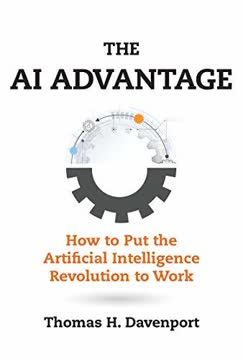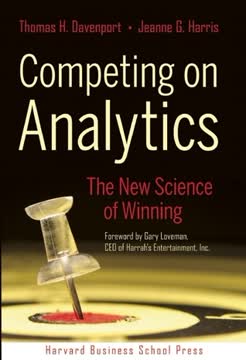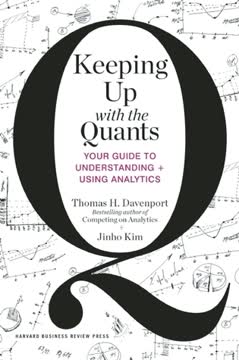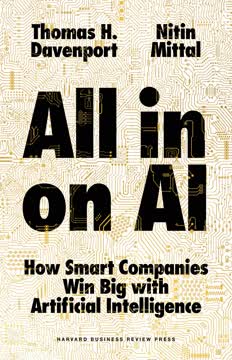Key Takeaways
1. AI's Enterprise Embrace: A Slow but Steady Revolution
I certainly agree that some of this excitement is warranted.
Cautious optimism. While AI hype abounds, a measured approach is crucial. The technology holds immense potential, but its integration into enterprises is an evolutionary process, not a sudden revolution. Early adopters faced challenges, highlighting the need for realistic expectations and strategic alignment.
Enterprise enthusiasm. Despite the measured pace, enterprise managers express strong optimism about AI's potential. Surveys reveal that a significant majority believe cognitive technologies are vital for both internal processes and product offerings. This enthusiasm underscores the growing recognition of AI's transformative power.
Early stages of adoption. Despite the enthusiasm, AI adoption is still in its early stages. Many organizations are experimenting with the technology but haven't yet fully integrated it into their core operations. This suggests a need for continued exploration, strategic planning, and a focus on practical applications.
2. Cognitive Technologies: A Trio of Business Capabilities
Broadly speaking, AI or cognitive technologies employ such capabilities—previously possessed only by humans—as knowledge, insight, and perception to solve narrowly defined (with the current state of technology) tasks.
Three core capabilities. AI's impact on business can be categorized into three key areas:
- Automating structured and repetitive work processes
- Gaining insight through extensive analysis of structured data
- Engaging with customers and employees using natural language processing
Technology diversity. These capabilities are enabled by a range of underlying technologies, including machine learning, neural networks, natural language processing, and robotic process automation. Understanding these technologies and their specific applications is crucial for effective implementation.
Business-driven approach. Focusing on business capabilities rather than specific technologies allows organizations to align AI initiatives with strategic goals. This approach ensures that AI investments are directed toward solving real-world problems and creating tangible value.
3. Process Automation: Streamlining Repetitive Tasks
The automation of digital and physical tasks—most often back-office administrative and financial activities—was the most common activity we found.
RPA dominance. Process automation, particularly through robotic process automation (RPA), is the most prevalent application of AI in business today. RPA involves automating structured digital tasks, mimicking human interaction with information systems.
Benefits of RPA:
- Cost-effectiveness
- Ease of implementation
- Quick return on investment
Beyond cost savings. While RPA can lead to staff reductions, its primary value lies in improving efficiency, reducing errors, and freeing up human workers for more strategic activities. This shift enables organizations to optimize processes and enhance overall performance.
4. Cognitive Insight: Unveiling Patterns in Vast Data
Applications that use algorithms to detect patterns in vast volumes of structured data and interpret its meaning—think of it as “analytics on steroids”—are the second broad AI category in business.
Analytics on steroids. Cognitive insight leverages machine learning algorithms to identify patterns and extract meaning from large datasets. This capability enables organizations to make more informed decisions, predict future outcomes, and optimize performance.
Applications of cognitive insight:
- Customer propensity modeling
- Fraud detection
- Predictive maintenance
- Personalized ad targeting
Data-driven decision making. Cognitive insight empowers organizations to move beyond traditional analytics and make data-driven decisions with greater precision and speed. This capability is particularly valuable in industries with vast amounts of data and complex decision-making processes.
5. Cognitive Engagement: Enhancing Interactions with Intelligence
These applications, the least common of the three, engage employees and customers by providing them with rich language or image-based personalized information and services.
Personalized experiences. Cognitive engagement focuses on enhancing interactions with customers and employees through personalized information and services. This category includes intelligent agents, chatbots, and recommendation systems.
Applications of cognitive engagement:
- 24/7 customer service
- Internal service sites for employees
- Product and service recommendation systems
- Health treatment recommendation systems
Human-machine collaboration. While cognitive engagement offers the potential for automated interactions, it's crucial to maintain a balance between automation and human touch. This ensures that customers and employees receive the support and guidance they need, while also leveraging the efficiency and scalability of AI.
6. Building a Cognitive Corporation: Key Capabilities
A key aspect of “what’s happening now” with AI in business is not only applications, but capabilities.
Beyond applications. Becoming a cognitive corporation requires more than just implementing AI applications. It involves building a set of core capabilities that enable organizations to effectively leverage AI across their operations.
Key capabilities:
- Understanding AI technologies and their applications
- Leveraging existing strengths in big data and analytics
- Creating a prioritized portfolio of AI projects
- Engaging in cognitive work redesign
- Focusing on scaling and achieving productivity benefits
Strategic alignment. Building these capabilities requires a strategic approach that aligns AI initiatives with business goals. This ensures that AI investments are directed toward creating sustainable competitive advantage.
7. Crafting a Cognitive Strategy: A Roadmap for Success
A strategy for AI/cognitive technologies can help to address this problem.
Strategic imperative. A well-defined cognitive strategy is essential for organizations seeking to maximize the value of their AI investments. This strategy should outline the organization's goals, priorities, and approach to AI implementation.
Key elements of a cognitive strategy:
- Defining objectives: What business problems will AI address?
- Identifying use cases: Where can AI create the most value?
- Assessing technology readiness: Is the technology up to the task?
- Developing a talent strategy: How will the organization acquire AI skills?
- Establishing a governance framework: How will AI be managed and controlled?
Proactive planning. By addressing these questions proactively, organizations can ensure that their AI initiatives are aligned with their strategic goals and that they are well-positioned to capitalize on the opportunities presented by cognitive technologies.
8. Navigating the Ethical Landscape of AI
The goal of this chapter was to introduce you to cognitive technology and to begin to address the overall context for its use by large organizations and vendors.
Ethical considerations. As AI becomes more prevalent, it's crucial to address the ethical implications of its use. This includes issues such as algorithmic bias, privacy, and the potential for job displacement.
Key ethical considerations:
- Ensuring fairness and transparency in AI algorithms
- Protecting privacy and data security
- Addressing the potential for job displacement
- Promoting responsible innovation
Proactive approach. Organizations should adopt a proactive approach to ethical considerations, establishing guidelines and frameworks to ensure that AI is used responsibly and ethically. This will help to build trust and ensure the long-term sustainability of AI initiatives.
9. The Future of Work: Augmentation over Automation
In the short run, AI will provide evolutionary benefits; in the long run, it is likely to be revolutionary.
Augmentation focus. While AI has the potential to automate many tasks, a more likely and desirable future involves augmentation, where humans and machines work together to enhance productivity and creativity. This approach leverages the strengths of both humans and AI, creating a more effective and fulfilling work environment.
Benefits of augmentation:
- Increased productivity and efficiency
- Enhanced creativity and innovation
- Improved job satisfaction
- Reduced risk of job displacement
Strategic advantage. By focusing on augmentation, organizations can create a more resilient and adaptable workforce, better positioned to thrive in the age of AI. This approach also fosters a culture of collaboration and innovation, driving long-term success.
10. Technology Choices: Build, Buy, or Blend?
The most aggressive users of artificial intelligence—both in their products and their internal processes—have been tech companies like Amazon .com.
Strategic technology decisions. Organizations face a range of technology choices when implementing AI, including whether to build their own solutions, buy them from vendors, or adopt a hybrid approach. The best approach depends on the organization's capabilities, resources, and strategic goals.
Factors to consider:
- Internal expertise: Does the organization have the skills to build AI solutions?
- Budget: How much can the organization invest in AI technology?
- Time to market: How quickly does the organization need to implement AI?
- Strategic control: How much control does the organization want over its AI technology?
Hybrid approach. A hybrid approach, combining open-source tools with proprietary solutions, can offer the best of both worlds. This allows organizations to leverage the flexibility and innovation of open-source while also benefiting from the support and expertise of vendors.
Last updated:
FAQ
What is "The AI Advantage: How to Put the Artificial Intelligence Revolution to Work" by Thomas H. Davenport about?
- Enterprise AI focus: The book examines how large organizations can effectively adopt and leverage artificial intelligence (AI) and cognitive technologies in business processes, products, and strategies.
- Practical over hype: Davenport emphasizes real-world applications and realistic expectations, steering clear of exaggerated claims about AI’s capabilities.
- Historical and current context: It traces the evolution of AI, from early expert systems to modern machine learning, using case studies from companies like Amazon and DBS Bank.
- Strategic and organizational insights: The book explores how AI impacts organizational structures, jobs, and business models, and provides guidance on managing these changes.
Why should I read "The AI Advantage" by Thomas H. Davenport?
- Balanced, realistic perspective: Davenport offers a nuanced view of AI, focusing on what it can realistically achieve for businesses in the short and long term.
- Actionable advice for managers: The book provides practical guidance for business leaders on developing AI strategies, selecting technologies, and scaling projects.
- Comprehensive coverage: It addresses AI technologies, business applications, workforce impacts, and ethical considerations, making it valuable for professionals and decision-makers.
- Preparation for change: Readers gain insights into managing organizational change, workforce transitions, and responsible AI adoption.
What are the key takeaways from "The AI Advantage" by Thomas H. Davenport?
- AI augments, not replaces: The book argues that AI is more likely to augment human workers than fully automate jobs, leading to new roles and skill requirements.
- Integration is challenging: Embedding AI into existing systems and processes is often more difficult than developing AI models themselves.
- Data and talent are critical: High-quality data and skilled AI practitioners are essential for successful AI adoption.
- Ethics and transparency matter: Addressing algorithmic bias, explainability, and responsible use of AI is crucial for long-term success.
How does Thomas H. Davenport define AI and cognitive technologies in "The AI Advantage"?
- Broad, inclusive definition: AI and cognitive technologies are systems that use human-like capabilities—such as knowledge, perception, and insight—to solve narrowly defined tasks.
- Task-focused approach: The book emphasizes that current AI technologies are best at augmenting specific human tasks rather than replicating entire jobs or full human cognition.
- Technologies included: Davenport includes machine learning, natural language processing (NLP), robotic process automation (RPA), expert systems, and physical robots under the AI umbrella.
- Evolving intelligence: The definition acknowledges the growing sophistication and integration of these technologies in business.
What are the main business applications of AI discussed in "The AI Advantage"?
- Process automation: Using RPA and AI to automate repetitive, structured back-office tasks, improving efficiency and reducing errors.
- Cognitive insight: Applying machine learning to analyze large datasets for purposes like fraud detection, predictive maintenance, and personalized marketing.
- Cognitive engagement: Deploying chatbots and intelligent agents to interact with customers and employees, enhancing service and support.
- Product and service enhancement: Embedding AI into products (e.g., autonomous vehicles, smart appliances) and creating new AI-driven business models.
What are the key AI technologies and methods explained in "The AI Advantage"?
- Machine learning and deep learning: Statistical methods that train models on data to predict or classify outcomes, with deep learning using neural networks for complex tasks.
- Natural language processing (NLP): Techniques for analyzing and understanding human language, including chatbots and speech recognition.
- Robotic process automation (RPA): Software robots that automate structured digital tasks by mimicking human interactions with IT systems.
- Rule-based expert systems and physical robots: Older AI forms using if-then rules and robots for physical tasks, now increasingly integrated with cognitive capabilities.
What are the main technical approaches to AI implementation in "The AI Advantage"?
- Embedded AI in software: Integrating AI capabilities into existing enterprise systems (e.g., Salesforce Einstein) for easier adoption.
- RPA as a gateway: Using RPA to automate structured tasks, often serving as an entry point to more advanced AI.
- Cognitive platforms and multi-vendor strategies: Larger firms may build or buy broad AI platforms or combine proprietary and open-source tools, requiring sophisticated integration.
- Data readiness: High-quality, well-integrated data is essential; companies may use AI itself to improve data management and integration.
What organizational and workforce changes does "The AI Advantage" predict due to AI?
- Task augmentation: AI will change the nature of work by augmenting many human tasks, requiring new skills and roles.
- New roles and skills: Demand will grow for data scientists, AI specialists, and “translators” who bridge business and technology.
- Process and structure redesign: Organizations must rethink business processes and structures to optimize human-machine collaboration.
- Gradual workforce impact: Displacement is expected to be slow and marginal initially, with productivity gains supporting economic growth.
How does Thomas H. Davenport advise companies to develop an AI strategy in "The AI Advantage"?
- Align with business objectives: Identify key problems or opportunities where AI can add value, focusing on strategic priorities.
- Prioritize and pilot projects: Evaluate use cases for feasibility and impact, and create a portfolio of pilots and proofs of concept.
- Build internal capabilities: Develop or acquire AI talent, invest in data infrastructure, and foster organizational understanding of AI.
- Plan for scaling: Prepare for integration challenges, change management, and continuous improvement to move from pilots to production.
What challenges and limitations of AI adoption are highlighted in "The AI Advantage"?
- Integration difficulties: Embedding AI into existing systems and processes is often the most significant challenge.
- Talent scarcity: There is a shortage of skilled AI practitioners, making it hard to build and sustain AI capabilities.
- Data quality and availability: Poor or siloed data can hamper AI effectiveness, requiring investment in data infrastructure.
- Organizational resistance: Employees and managers may resist changes, necessitating thoughtful change management and communication.
What ethical and social implications of AI are discussed in "The AI Advantage"?
- Algorithmic bias and fairness: AI systems can perpetuate or amplify biases, raising fairness and discrimination concerns.
- Transparency and explainability: The book highlights the need for explainable AI, especially in regulated industries and high-stakes decisions.
- Privacy and security: AI’s ability to analyze vast personal data raises privacy issues, and AI is both a tool for and a target of cybersecurity threats.
- Responsible adoption: Davenport stresses proactive management of AI’s organizational, social, and ethical implications.
What are some notable real-world examples of AI applications in business from "The AI Advantage"?
- Amazon Go stores: Use of image recognition and sensor fusion to enable checkout-free shopping, transforming retail operations.
- Bank of Montreal: Implementation of machine learning and RPA for customer segmentation, fraud detection, and process automation.
- GlaxoSmithKline R&D: Use of AI and machine learning to integrate research data and accelerate drug discovery.
- Facebook’s content moderation: Challenges in using AI to detect fake news and harmful content, illustrating both potential and limitations.
What are the best quotes from "The AI Advantage" by Thomas H. Davenport and what do they mean?
- Amara’s Law: “We tend to overestimate the effect of a technology in the short run and underestimate the effect in the long run.” This cautions readers to have realistic expectations about AI’s immediate impact while recognizing its transformative potential.
- Kevin Kelly on AI: AI is “cheap, reliable, industrial-grade digital smartness running behind everything, and almost invisible except when it blinks off.” This highlights AI’s future as a ubiquitous, behind-the-scenes utility.
- Jeff Bezos on AI impact: “Much of what we do with machine learning happens beneath the surface... quietly but meaningfully improving core operations.” This underscores that AI’s most significant benefits may be operational rather than flashy or customer-facing.
Review Summary
Readers found The AI Advantage to have a strong underlying message but criticized its lack of depth and reliance on widely-known examples. Some felt it offered practical insights for businesses considering AI implementation, while others found it outdated and repetitive. Positive reviews praised its accessibility and overview of AI's business applications. Criticisms included its focus on superficial AI technologies, consultant-like writing style, and limited exploration of more complex AI concepts. Overall, opinions were mixed, with readers seeking more in-depth analysis of AI's impact on work and industry.
Similar Books
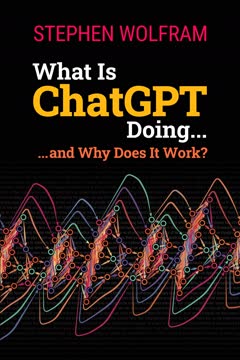



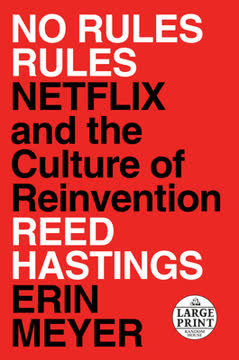

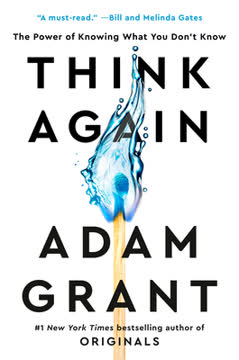


Download PDF
Download EPUB
.epub digital book format is ideal for reading ebooks on phones, tablets, and e-readers.
